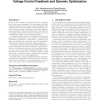97 search results - page 15 / 20 » Low power network processor design using clock gating |
ISLPED
2004
ACM
14 years 1 months ago
2004
ACM
Microprocessor designers use techniques such as clock gating to reduce power dissipation. An unfortunate side-effect of these techniques is the processor current fluctuations th...
IPPS
2007
IEEE
14 years 1 months ago
2007
IEEE
Hardware accelerators are increasingly used to extend the computational capabilities of baseline scalar processors to meet the growing performance and power requirements of embedd...
FPGA
2009
ACM
14 years 2 months ago
2009
ACM
Modern Field Programmable Gate Arrays (FPGAs) are capable of performing complex discrete signal processing algorithms with clock rates above 100MHz. This combined with FPGA’s lo...
DSN
2009
IEEE
14 years 2 months ago
2009
IEEE
Dynamic Information Flow Tracking (DIFT) is a promising security technique. With hardware support, DIFT prevents a wide range of attacks on vulnerable software with minimal perfor...
HPCA
2012
IEEE
12 years 3 months ago
2012
IEEE
Conventional out-of-order processors that use a unified physical register file allocate and reclaim registers explicitly using a free list that operates as a circular queue. We ...


